Looking to learn more about the ins and outs of dog parks? Check out our compilation of fascinating dog park statistics. Don’t take your dog to the park without reading these stats!
1. The United States has more than 800 dog parks.
With over 800 dog parks across the nation1, it’s evident that Americans have a deep love and appreciation for their furry friends. Dog parks provide dedicated spaces for our four-legged pals to romp, socialize, and exercise, reflecting our commitment to ensuring happy, healthy lives for our canine companions.
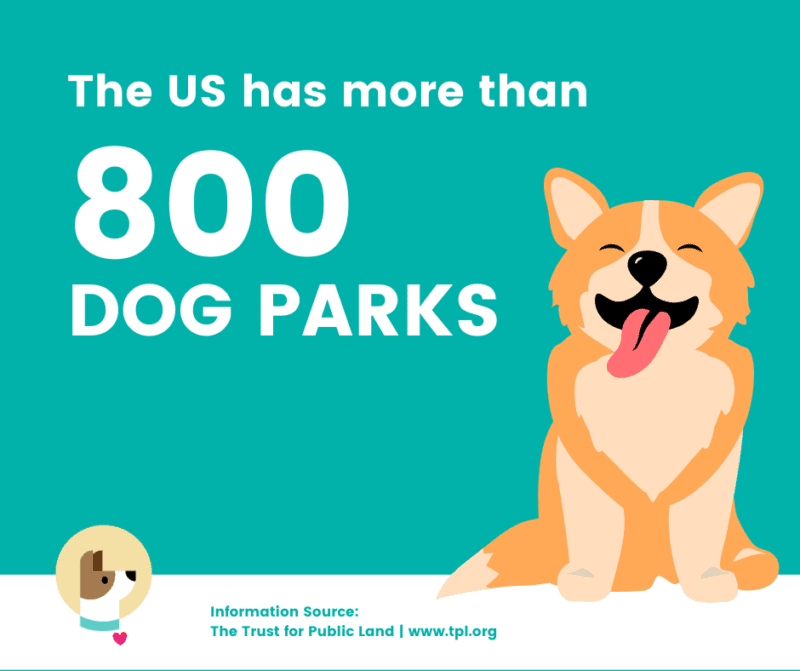
2. From 2009 – 2019, the number of dedicated dog parks in the US has increased over 42%
The whopping 42% increase1 in dog parks over a decade hints at the growing popularity of dog ownership in the US. As more families welcome furry friends into their homes, the demand for pet-friendly amenities like dog parks has surged.

3. Ohlone Dog Park in Berkeley, CA is recognized as the first dog park in the world.
Nestled in the vibrant city of Berkeley, the Ohlone Dog Park (recently re-named the Martha Scott Benedict Memorial Park) was established in 1979.
The concept of a designated off-leash area for dogs was quite revolutionary at the time. Its development was led by the late Doris Richards and a group of local dog owners who came together with the innovative idea of creating a safe space where dogs could roam freely and socialize.
The success of this groundbreaking initiative inspired other communities across the United States and the world to follow suit. The park is a true a testament to the power of community organizing!
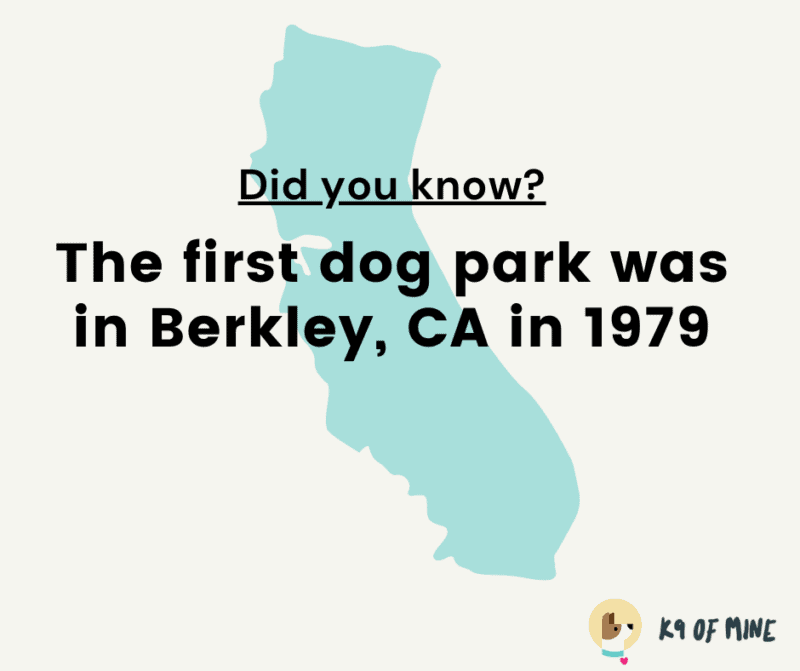
4. Boise, Idaho, is the city with the most dog parks per capita, with 6.66 off-leash dog parks per 100,000 residents in 2021.
This is shortly followed by Portland, OR and Henderson, NV with 5.81 and 5.29 dog parks per 100,000 residents respectively.2
Portland, Oregon has tons of dog parks. In total, they’ve established a network of 33 off-leash areas which remains the second largest both in count and per capita in the country.
5. Roughly 91% of Americans believe dog parks provide benefits to the community
Of the benefits individuals believe dog parks provide, the list includes3:
- Giving dogs a safe space to exercise and roam around freely (60%)
- Allowing dogs to socialize with other dogs (39%)
- Allowing owners a chance to be physically active with their pet (36%)
6. More than 1 in 7 dog owners report their dogs having been attacked in a public dog park
Increasingly more owners are becoming aware of the danger dog parks present, and this is supported by the data that 1 in 7 dog owners have reported their dog being attacked at a dog park.
Dog parks can be unpredictable environments. With different dogs, personalities, and energy levels coming together, it’s an environment ripe for conflict.
The risk of dog-on-dog aggression can lead to physical injuries or lasting emotional trauma for both dogs and their humans.
As a responsible pet parent, it’s essential to be aware of these risks and take steps to protect your fur baby. You can do this by taking the following precautions:
- Read up on appropriate dog park etiquette and know what warning signs to watch for.
- Be proactive by observing the dogs and their behavior before entering the park.
- Know your dog’s temperament, and don’t hesitate to leave if you feel the environment isn’t suitable.
- Educate yourself on canine body language to identify potential conflicts before they escalate.
- Keep an eye on your pup at all times.
- Consider pursuing dog park alternatives like group dog hikes and nature walks if your dog is overwhelmed by the traditional dog park design.

7. 26% of dog park attendees feel other dog owners are irresponsible with their dogs in public.
The potential dangers of dog parks can often be traced back to human behavior. According to a Sniffspot survey4, 26% of dog park attendees feel that other dog owners are irresponsible with their dogs in public.
This lack of responsibility can lead to a variety of issues, posing risks to the safety and well-being of both dogs and their humans.
Irresponsible dog ownership can manifest in several ways, including:
- Poor supervision
- Inadequate socialization
- Ignoring basic dog park etiquette
Dog owners who fail to monitor their pets closely or who are distracted by their phones may miss warning signs of potential conflicts or aggressive behavior.
Additionally, some owners may bring dogs with poor social skills, who are not well-suited to the dog park environment, increasing the likelihood of scuffles and altercations.
Furthermore, failure to follow dog park rules, such as not picking up after one’s dog, can lead to unsanitary conditions, which may contribute to the spread of diseases and parasites.
8. More than 50% of park and recreation agencies have at least one dog park.
The NRPA reported in 2018 that over half (55 percent)4 of park and recreation agencies have at least one dog park, illustrating the increase in dog park popularity.
9. Bonus amenities like dog washes can drive extra revenue for park programs.
Certain dog park amenities have the potential to bring in significant revenue for park programs. Take Santa Barbara County Parks — their six dog wash machines collectively generate an impressive $120,000 in annual revenue (or $2,500 per week).5
Although the county parks don’t track the exact number of washes, each wash costs $10, meaning their six machines complete approximately 250 dog washes per week.
The majority of these washes (about 90%) occur at beach locations. This makes sense, as most owners don’t want their sand-covered pup making a mess of their car.
The additional funds generated by these kinds of amenities have potential to be used to enhance the park department’s budget for maintenance and improvement projects.
10. The ideal size for an urban dog park is at least 1 acre.
Experts suggest that an urban dog park should ideally be at least 1 acre in size. Smaller parks can create various safety concerns for dogs and their owners.
When a dog park is too small, it can lead to overcrowding, which increases the likelihood of conflicts and aggressive behavior among dogs. High-energy play and interactions can quickly escalate in a congested space, making it challenging for owners to intervene and separate their dogs if necessary.
11. 1/3 of American homebuyers listed “better space for their dogs” as a top-three motivator
As more individuals see their dogs as akin to children, relocating to areas that can better serve their dogs is common, with 1/3 of US homebuyers citing finding a better space for their dogs as one of their top three motivators for purchasing a home.7
Wealthy families with pets have been shown to often choose neighborhoods expressly due to their dog-friendly facilities, such as dog parks.
12. 80% of dog park attendees expressed willingness to pay an annual fee for higher-quality dog parks
Many pet parents are willing to pay for a clean, safe, well-maintained dog park. Conservative estimate of average willingness to pay roughly $56.17 per household, per year.8
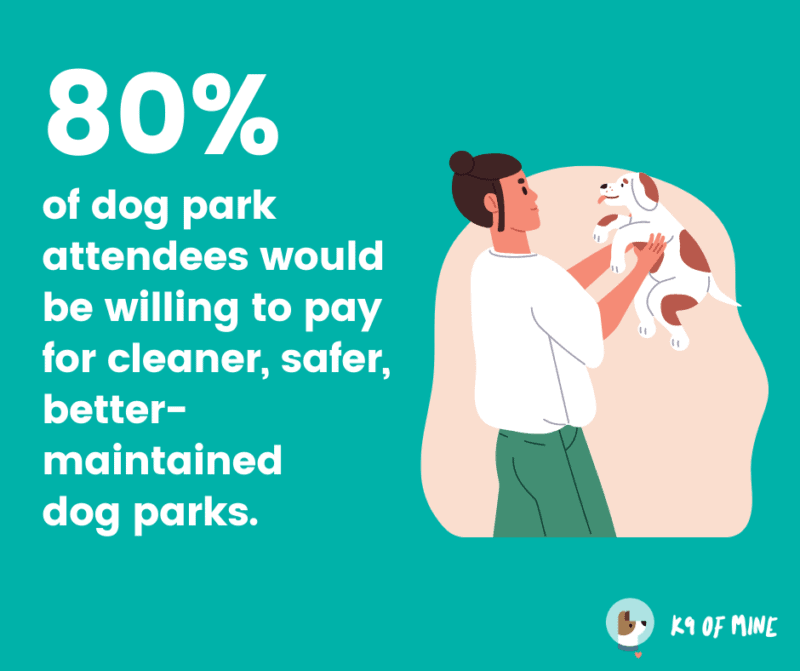
13. 72% of dog park usage occurs on weekends
One study found that 72.7% of park use occurs on weekends, with the remaining 27.3% on weekdays.8
This pattern of park usage highlights how dog parks can provide a much-needed break from the daily grind for owners, even serving as a recreational oasis for people seeking to unwind and recharge during their time off.
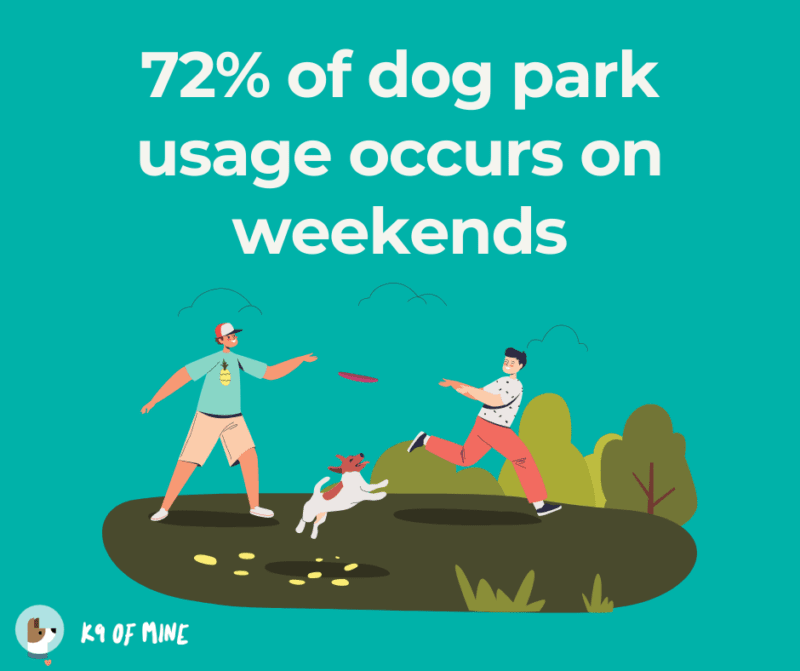
14. Peak use of dog parks occurs in the evenings.
The same study found that the peak use of dog parks was in the evenings, with the slowest hours being in the afternoon between 1:00 PM and 5:00 PM.
The lull in dog park attendance during the afternoon hours could be attributed to factors such as the heat, particularly in warmer climates, and people being occupied with work or other responsibilities.8
15. Over 50% of dog park attendees spend 30-60 minutes in the dog park
Roughly half (52.5%) of dog park attendees observed in one study spent between 30 minutes
and 60 minutes, while 36% spent less than 30 minutes in the parks.8
A smaller number of visitors (12%) were observed to spend over one hour in the dog park.
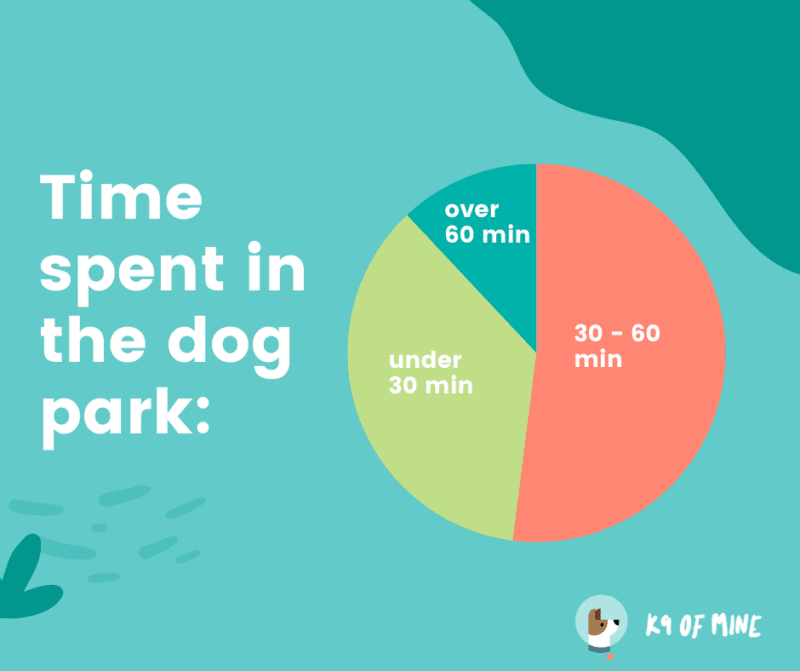
16. Dog parks are the primary source of exercise for 33% of dogs
One study surveying residents across several communities surrounding a number of dog parks reported that methods for exercising survey respondent’s dogs included dog parks (33.4 %), followed by walking around neighborhoods (31.0 %) and the backyard (18.3 %).8
This is somewhat troubling, as backyard activity is not a suitable amount of enrichment or activity for most dogs.
While dog parks have the potential to provide a source of exercise and socialization, most dogs will still benefit significantly from daily walks, giving them ample opportunity to explore, move, and smell.
17. The primary reason owners visit the dog park is to exercise their dogs.
One study reports that the main reasons people visit the dog park is to exercise their dogs (29.5%), followed by having their dogs socialize with other dogs (25.9%), and socializing with other dog owners (14.5%).8

18. Over 58% of dog park attendees are women.
A 2016 study conducted over several dog parks across the US found that 58.5% of dog park attendees are female.9
19. 90% of dog park attendees are white
A 2016 study surveying several dog parks across different areas of the US found that 90% of dog park users were white.9 This supports the association of dog parks with gentrification.
Dog parks are often only an amenity for higher-income residents. To exemplify this, for many years (until quite recently) Chicago’s North Side, composed mostly of white residents, boasted 22 dog parks, with none on the lower-income South Side.

20. 70% of dog park attendees drive in order to access the park.
Most participants drove to the park (70.4%), followed by walking (26.2%), bicycling (2.0%), public transportation (1.0%), and other (0.3%). On average, dog park attendees live roughly 2.5 miles from the dog park that they choose to attend.9
21. Litigation issues can be a problem for dog parks
While dog parks have become increasingly popular, they haven’t been without their share of legal disputes and concerns.
The most common issues involving dog parks typically revolve around injuries, dog bites, and noise complaints.
Laws and regulations regarding dog bites and owner liability vary by state, but generally, dog owners are responsible for their pet’s behavior in public spaces like dog parks.
Dog parks can sometimes be the source of noise complaints from neighboring residents. Excessive barking, yapping, or other noises from dogs may be deemed a nuisance, leading to disputes between dog park users and nearby community members (ex. Rocky River v. Lakewood).
In some cases, these complaints have resulted in legal battles over whether the dog park should be allowed to continue operating or if modifications, such as sound barriers or limited hours, should be implemented to mitigate the noise.
Legal issues can also arise from the design, construction, and maintenance of dog parks. For instance, if a dog or person is injured due to poor maintenance or a hazardous design element within the park (ex. Warren v. City of Piedmont), the responsible party (e.g., the park’s management or the local municipality) could be held liable for negligence.
22. Natural grass is the most popular surface to be used in a dog park.
Natural grass is the most popular substrate for dog parks, and for good reason — it’s comfortable for pups, natural for the environment, and offers plenty of sniffing opportunities for dogs.
There’s even some discussion over what types of grass are best for dogs and dog-heavy environments, but that usually depends on the region in which you live (generally, heartier grass is better).
Artificial turf or gravel is more likely to cause abrasions or irritations on a dog’s skin. Natural grass also stays cooler in hot weather compared to artificial turf, which can absorb and retain heat.
Most popular surfaces for dog parks include:
- Natural Grass
- Artificial Turf
- Manufactured Wood Fiber
- Mulch
- Sand
- Pea Gravel
- Decomposed Granite
- Cement
Cement is arguably the worst material for dog parks. Despite being easier to maintain, it is comparatively sterile and eliminates the ability for dogs to sniff natural scents in grass and greenery.
A more sterile environment puts more emphasis and pressure on dog-on-dog interactions, which can increase stress and the likelihood of doggie disagreements.
Sources:
- TLPL.org
- Source: Statistica
- NRPA.org
- Sniffspot.com
- https://evolutiondogwash.com/
- Harris, Matthew, “Responsible Pet Ownership: Dog Parks and Demographic Change in Portland, Oregon” (2017). Dissertations and Theses. Paper 4151.
- SunTrust Mortgage
- Hyung-Sook, Lee, (2007). “A Study of Use Patterns, User Satisfaction and Willingness to Pay for Off-Leash Dog Parks: PostOccupancy Evaluations of Four Dog Parks in Texas and Florida.”
- Evenson, K. R., Shay, E., Williamson, S., & Cohen, D. A. (2016). Use of Dog Parks and the Contribution to Physical Activity for Their Owners. Research quarterly for exercise and sport
- Allen, Laurel, “Dog Parks: Benefits and Liabilities” (2007). Master of Environmental Studies Capstone Projects. 18.






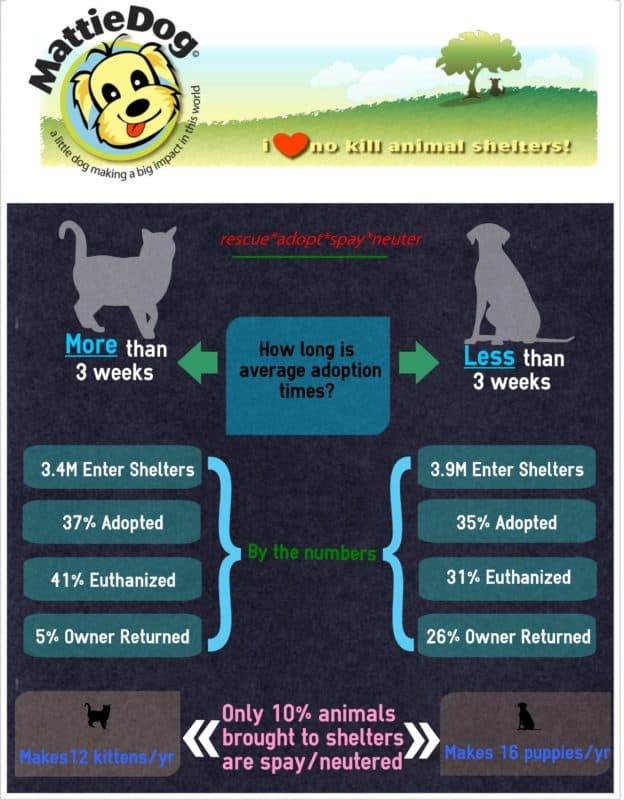

Leave a Comment